Welcome to the web design section. My experience with this field has always been somewhat of a peculiarity, as I never truly intended to design websites in the first place. I designed my first website around the end of 1994, when my family signed up for America Online service over a 2,400 bps dialup connection. I was 9, going on 10, at the time. Though I originally had no intention of designing websites as anything more than a casual activity, I soon found that my skills (which I must always make sure are up to date in this ever-changing field) were in high demand. After designing a number of personal and freelance sites, learning XHTML, CSS, Javascript, Perl, and MySQL in the process, I began working as a professional web developer for Kaller Historical Documents in May of 2001. Though I left in 2003, I am still frequently asked to design websites. Many of my sites have won "highest rated" awards on SiteCritique and other website rating services. There is something that sets me apart from most web developers: I am a programmer and a utilitarian. I won't use or discard elements due to web dogma (or any other reason than using the right tool for the job), though I do code to standard XHTML. Unsurprisingly, this makes me much faster and my sites much more compatible than most web developers can boast.
|
|
| |
 Thumbnails: 1 2 3
|
"Purpose. Humanity. Success." It's what I live by.
By sheer data mining, determination, and force of will, created a product which can automatically diagnose breast cancer on a mammogram with above 90% accuracy (on a dataset of 2,000 film mammograms, no less - FFDM should be even more accurate), coded it up, wrote all of the copy, designed and coded the website, incorporated a business around it, and brought it to beta by October 2011. Wrote up and filed a provisional patent, published a journal paper, and started on a mobile application. Responsible for all facets of system administration and maintenance, and just about all things technical.
Published "Mammographic Segmentation Using WaveCluster" in the 2012 medical informatics special edition of "Algorithms".
Date: October 4, 2011.
|
 Thumbnails: 1 2
|
The Polymath Lectures are a series of courses (mostly online) that we are offering at Project Polymath to generate interest and to raise funds. Over 50 prospective instructors have applied during the first month of the program.
I'm not merely organizing this and sitting idly by, however; I'm also acting as the instructor of the first course, "How To Create Your Own Website". This was one reason I sought a teaching position last year; to have the experience to act as an instructor here, with an innovative educational paradigm at stake.
Between an imminent dissertation defense, my normal teaching load at Monmouth, and the effort of teaching this course, my ability to multitask was pushed to its limit. I'm well past the point of adding significantly to my own burden, but it's a burden borne in the name of something right, and that makes all the difference.
Date: April 4, 2009.
|
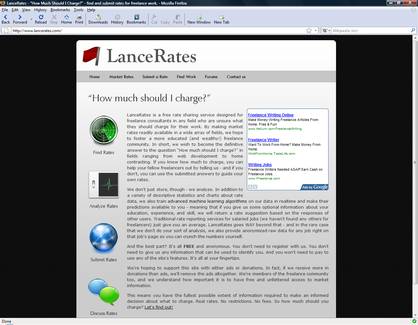
|
LanceRates is a freelance rate sharing service - the first of its type for freelancers, in fact. Too often was the question "How much should I charge?" asked in freelancing forums - and the answers varied widely because the sample size of each response was 1.
No longer. I hope that LanceRates will become a centralized resource for freelancers to share information on how much they charge, taking variables such as education, experience, skill, and location into account.
And because sites such that disclose little more than means or charge for access to their full data bug us all, the complete dataset is made available free of charge. LanceRates uses all sorts of advanced charting libraries and machine learning algorithms to analyze the data (and will even suggest rates for you based on other users' responses), but if it doesn't do what you want it to, you can still run your own analysis using the dataset.
THIS is the power of data mining. And whether or not this site succeeds, it is what all sites will be in the future. (It has lots of AJAX too, though it gracefully degrades, so it's what sites are in the present as well).
And I created it in only 9 days, machine learning algorithms and all. I have a library of modularized functions I needed to write that grows with every project I undertake. Consequently, my already-fast development time just keeps getting faster.
Date: June 10, 2008.
|
 Thumbnails: 1 2
|
Project Polymath is my ambition to start a new type of university that encourages student-driven, simultaneous, and modular learning in multiple fields, as well as instruction in techniques to creatively generate ideas and fuse principles from across disciplines. The idea is to spark a new Renaissance by training an entire generation of polymaths rather than relying upon the rare autodidactic individuals, as was done in the past.
I had thought over the idea for a few years beforehand, but first acted on it on December 21, 2007 by creating the website (it was completed on December 24, 2007). In it, I lay down the principles of my vision, philosophy, and plan for instituting the university.
I have also started a 501(c)(3) nonprofit organization called the Polymath Foundation dedicated to funding and managing the university. We were incorporated on March 20, 2008 and received 501(c)(3) status on September 11, 2008, after which we rapidly began drawing up a curriculum.
As of April 2009, we have a board of 5 trustees and 3 executive committee members, we have planned 5 courses and taught 2, and we have nearly 100 students, 500 supporters, and 50 prospective instructors. Not bad for the organization's one-year anniversary, right?
This is an ambitious project; one of my life's goals. Fortunately, I am not alone in this - we get multiple emails daily from all sorts of people (including faculty and administration at other universities) praising the concept, and have quite the dedicated network of supporters.
It's also a good example of how my web design has been evolving.
Of all of my efforts, this is likely the one to watch most closely.
Date: December 24, 2007.
|
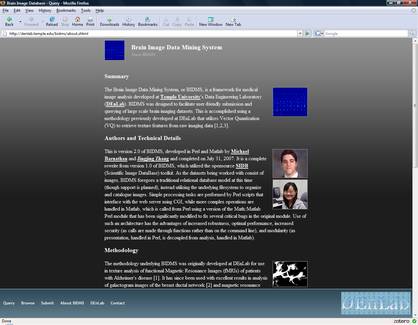
|
The Medical Image Data Mining System is a framework for automated medical (primarily brain) image dataset submission and analysis which I wrote as a Master's Project (with the help of Jingjing Zhang, another graduate student) over the course of just one week. The system is written in Perl and Matlab and employs a methodology that achieved 89% classification accuracy on MRI images of the brain in another study (which we submitted in a separate paper to the same conference). Thus the system has diagnostic accuracy sufficient for clinical use in applications such as cancer diagnosis.
The associated paper was presented at ISBI 2008 and published in proceedings.
Date: August 1, 2007.
|
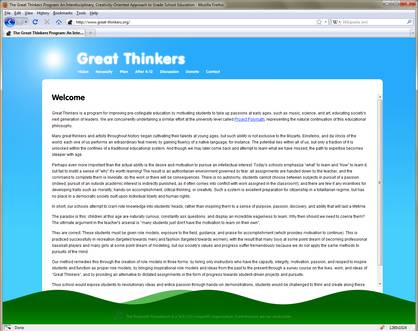
|
An extension of the Project Polymath concept into grade-school education was long in coming. Nevertheless, it is an ideal time to move in this direction. Educational reform is coming to this country soon, and a program that seeks to instill creativity, innovation, and a love of learning will do very well when it does.
More than that, this is a stepping stone to the university - for its establishment and for its future students.
Date: October 23, 2009.
|
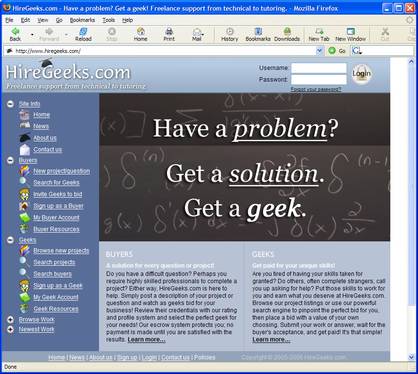
|
HireGeeks.com is the name of my first business venture.
HireGeeks.com is a freelance support service. It uses techniques seen on sites such as Google Answers and RentACoder, but does not limit them in scope to only questions or development projects. As the motto states, HireGeeks is a service for all types of "freelance support from technical to tutoring".
The site itself uses XHTML, CSS, about 10,000 lines of Perl code, and MySQL. Though this site uses all of the latest techniques, such as AJAX, I paid quite a bit of attention to details such as Javascript support in the browser (you can completely disable it and the site will function perfectly, including the functionality provided by AJAX - the XMLHttpRequests become normal page loads) and security (for example, if you lose your password, even I cannot recover the financial information from the database, which contains neither unencrypted financial information nor the user's password. As a result, if you do lose your password, you'll need to reenter your financial information along with the new password).
On the business end of things, this also taught me quite a few experiences in entrepreneurship. I despise needless complexity, so naturally I spent as little on the business as possible, and therefore stand to lose next to nothing ($354, to be precise) if it does not succeed. I now know how to register a trade name, obtain a PO Box, file business taxes, and handle Internet payments, among other things.
This is good, because if this business does not succeed, I will continue working on businesses until one does. I am determined to succeed because I will neither condemn myself to a life of poverty because I wish to do research nor abandon my research goals in order to compromise financially. I eventually would like to start a university. Needless to say, this ambitious goal is going to require more than a professor's salary.
This is a very low maintenance business. Transactions are run through the site, and I don't typically have to be around to proccess them (unless someone submits a check as payment). Temporal as well as monetary costs are minimized. The expense I paid for this was four months of developing and debugging the backend code of the site, but it is a one-time expense and will save much in the long run.
Date: August 23, 2005.
|
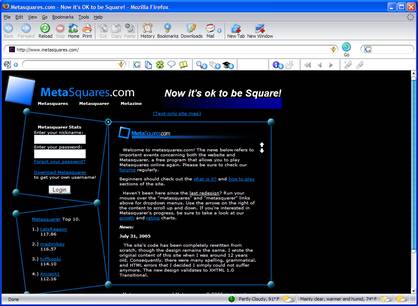 Thumbnails: 1 2 3 4
|
Reviews There are many other reviews of the game, but most are not quantitative or from such well-known sites.
The Game
Metasquarer is the rather ambitious project that I undertook after one of my favorite games, Metasquares, was pulled from America Online in September of 1997. I was 12 years old at the time. Originally an AI that worked in conjunction with the original game's solo mode by sending Windows messages to the appropriate places on the board (simulating mouse clicks), Metasquarer quickly became an earnest replacement of the original when I realized that the ability to place pieces in arbitrary spaces on the Metasquares board was better utilized by a network layer than by an AI. At this point, I wanted to change the name to "Metasquared", but the old name stuck. I sat down with a copy of RFC 1459 (a detailed specification of the Internet Relay Chat, or IRC, protocol), and out of this idea came the first four versions of Metasquarer. In 2000, I decided that the limitations of using the existing game's engine outweighed the benefits that it provided. Thus, I began working on Metasquarer 5.0, a complete rewrite of the game that used its own board and algorithms. The game became as feature-rich as the original... but I wasn't finished. I gradually added all of the features I wished to see in the game, including skinning, an AI opponent, plugins, an intricate rating system (that fixed the "soft" rating problems of the original Metasquares rating system, which are similar to the problems with scoring on an adaptive test), and the ability to check and update your status, including a detailed history of past games, on the metasquares.com website.
The game is currently at its seventh major version. There have been 72 revisions in total. For the most part, development has stopped with waning player interest, but there are very few bugs left and the game is as feature-complete as I can think to make it. At its peak, Metasquarer had above 50,000 downloads and over 8,000 active users (registration began in version 6.0; it is likely that the majority of the difference between downloads and users were the cumulative userbase of all earlier versions). Since wiping the database in November of 2003, Metasquarer has accumulated about 2,000 guaranteed active users. It has a 5 cow rating, the highest given, on Tucows, and had (until they began charging to keep programs listed) above a 90% approval rating on Download.com.
The Website
The game's website is metasquares.com. I originally registered this site in 1999; earlier versions of the game were kept on my personal website. The site is built using a Perl/mySQL backend and utilizes some very innovative methods of client/server communication between individual copies of the game and the player database to avoid excessive load. Metasquares.com has won many SiteCritique awards, including "Best overall", "Best graphics", and "Best browser compatibility". This is the first site of note that I designed, though ProgrammerFAQ.com preceded it. I was assisted in creating the latest incarnation of the site by Curt Wallach, an avid Metasquares fan. I rewrote the entire site's code from scratch from July 31, 2005 to August 2, 2005. It is now valid XHTML 1.0.
Date: September 1, 1997.
|
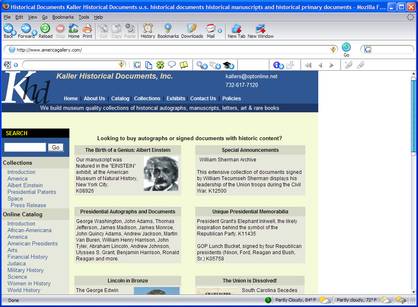 Thumbnails: 1 2 3 4 5
|
As a Milestone
The beginning of my work as a web developer and administrator for Kaller Historical Documents was a turning point in my life. Though a drive to excel at all that I did was always part of my nature, I had previously assumed that success could be found passively, by following the prescribed roles that society assigned people of my age. I was content as the fastest cashier in the (Shoprite) supermarket I had previously worked in, but I was still content being a cashier. However, after beginning work at KHD, I realized that success lies in breaking free from society's expectations, for everyone else was following them. Furthermore, and more importantly, I realized that the differences that I had been ostracized for during my elementary and high school years were precisely what would enable me to succeed, rather than a simple pastime. After working at KHD, I vowed to use my unique skills whenever possible to perform great things. This attitude would serve me well through my undergraduate college years, culminating in the publication of a research paper.
As a Position
My duties in this position were to maintain the organization's website, systems, and network. My work was quickly recognized by my superiors, and I was given a pay raise one week after I began working for the company. Soon afterwards, I became the lead web developer for the organization, charged with the responsibility of redesigning the website and, at my own suggestion, creating a content management and order processing system with an administrative frontend to handle the rapidly growing inventory of documents, already well over 10,000 items large. The first version of the design/CMS was complete in about a week, with more advanced features, such as search, added later. Following the rollout and initial document import of the CMS (the latter taking over a month, as no digital records of the inventory were previously kept), the volume of orders increased more than twofold.
I regretfully resigned in 2003 when my university and work schedules became mutually exclusive.
As a Website
The original Americagallery.com website was purely textual, and was updated manually.
The first redesign of the site, started in June of 2001, used a red and white color scheme, with a navigational frame on the top and a combination of graphical and textual content on the bottom. This was the first version of the site to incorporate my CMS. This design can be seen in the fourth thumbnail in the list.
The second redesign of the site was completed approximately one year later, in July of 2002. This design was more graphical, very structured, and done in a blue and white color scheme. Of all of the designs that the site has used, I consider this one the best. This design is shown in the fifth thumbnail in the list.
The third, and current, design was completed by Singlethrow, a consulting firm that KHD had previously hired for search engine optimization, after my departure. The site retains its structured appearance, but the color scheme has been changed to blue, white, and a light brown with a bit of green. The first through third thumbnails show this design.
Date: May 4, 2001.
|
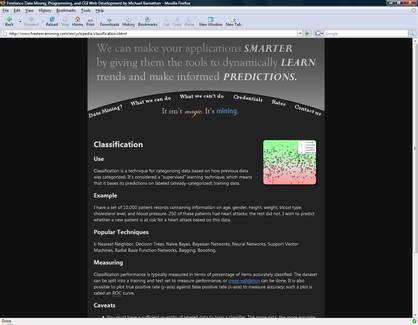
|
I realized that my own interdisciplinarity was going to allow me to do some very unique things when I thought of combining my software and web development talent with my data mining talent. From this, Freelance Mining was born.
It's a service I offer in which I will integrate mining techniques into software to make it "smarter" - able to pick up patterns and learn trends.
This is a different service, and requires a different website, so I decided to discard some of the assumptions I had made on all of my previous web design projects and design a site that fit what I was trying to do. I'm very happy with the result - it's functional, informative, and remains aesthetically pleasing even though it doesn't follow typical design assumptions.
Oh, I also have a small encyclopedia of data mining terms and techniques on this site. It should be an informative resource for those wishing to learn more about the techniques.
Date: February 28, 2008.
|
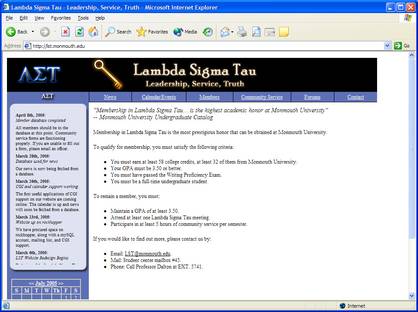
|
As a Member
On March 20, 2005, what the student handbook calls "The highest academic honor at Monmouth University" was conferred upon me: I was inducted into the Lambda Sigma Tau honor society, for outstanding academic achievement and service.
As an Officer
Immediately following my induction, I began my official tenure as an officer of this society, though my duties began beforehand. I was responsible for creating the induction brochure, keeping track of the 415 copies of the brochure that were made from my design, and distributing these to inductees and their guests at the induction ceremony.
Following the induction, I performed various tasks for the society, including coordinating community service events and future inductions.
As Webmaster
I am also responsible for redesigning and maintaining the official Lambda Sigma Tau website, located at http://lst.monmouth.edu. This site, with the exception of some static content on the homepage, is entirely database driven. Using the backend that I've developed, members can log in to check and update their community service records, officers can modify site preferences and approve community service hours, and the general public can view news and events relating to Lambda Sigma Tau.
Criteria
There are strict criteria for membership in this society: A GPA of at least 3.5 and at least 65 credits at the time of induction, continuous maintenance of a 3.5 GPA, and the performance of at least 5 hours of community service per semester.
The criteria reflect the motto of the society:
“Leadership, Service, Truth”.
Date: March 20, 2005.
|
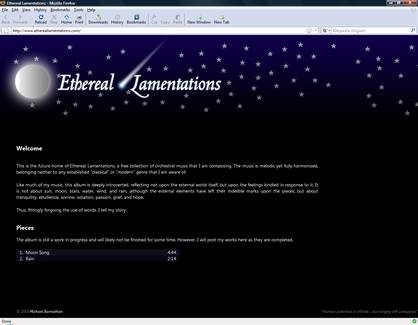
|
"Ethereal Lamentations" is to be the title of my first musical album. It will likely be in progress for a great deal of time, as I don't have the time I used to have to devote to my music, but I will post new pieces as they are written until the album is complete.
The central theme is not nature, but the emotional reaction to nature.
Date: July 12, 2008.
|
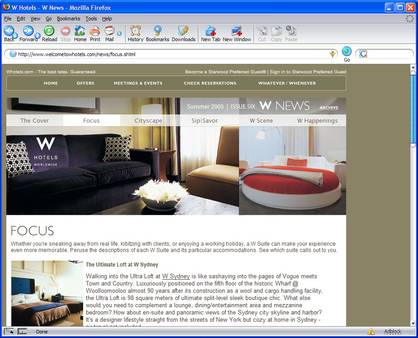
|
W News, part of the W Hotels website, is the second website that I designed for RDA International. This website was considerably more difficult to create than Civilization Anonymous, as deadlines were extremely tight (two days from concept to working site) and I had to process the images given to me by the design firm myself. Nevertheless, I managed to finish this project on time. As with all of my work, this site conforms to standard XHTML and CSS.
Date: July 20, 2005.
|
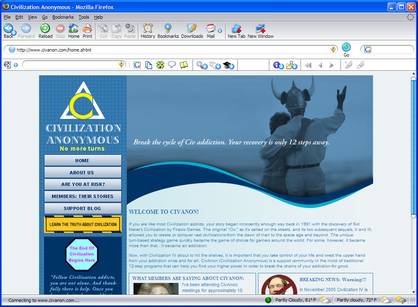 Thumbnails: 1 2
|
This website was designed for RDA International, a design firm. I was supplied with an image of each page's design and asked specifically to hand-code the site to specifications in a three-day deadline. I completed the site, which is valid XHTML 1.0, with a day to spare. I have since been contacted for repeat work by RDA.
The site won a gold medal in the "Product Promotion Trailer" category of the 2006 MI6 Game Marketing Awards.
I recently did a followup search on the site to gauge users' reactions. To say that they were positive is an understatement; I am quite humbled to participate in something that has garnered so much praise:
“2K Games did a tremendous job marketing Civilization IV... the CivAnon campaign was probably the pièce de résistance of the whole marketing effort,”
--Kelley Gilmore, Firaxis
“The Civanon marketing promotion kickoff was very well received, and I think we have a lot of momentum as we head toward the finish line”
--Barry Caudill, Firaxis
“That was one of the best promotions I have ever seen for a game.”
We rarely post any news about fan-sites because... well... let's be honest... fansites generally suck. But we definitely wanted to make an exception for this one which is called ‘CivAnon’ or ... “Civilization Anonymous”.
And on, and on, and on... Date: May 11, 2005.
|
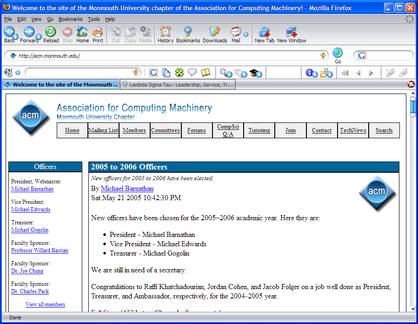
|
This thumbnail displays the website of the MU ACM Chapter, as I designed it at the beginning of my tenure as Vice President and Webmaster of the chapter (Oct. 2004-May 2005).
As this was the first year that the ACM chapter was "unfrozen" as a student organization, my initial tasks were to recruit new members and ensure that other university and national ACM requirements were met. As of April 2005, our chapter's official status has been changed from "Provisional" to "Active" with the completion of an annual report to the national ACM.
In May of 2005, I became the President of the chapter. My focus for the 2005-2006 academic year will be on recruiting new membership to replace the graduating class, improving the computer science department's pass rate by offering tutoring programs to undergraduate computer science students, organizing fundraisers for the chapter, and ensuring the solvency of the chapter after the current officers (who all belong to the senior class) graduate.
Date: October 8, 2004.
|
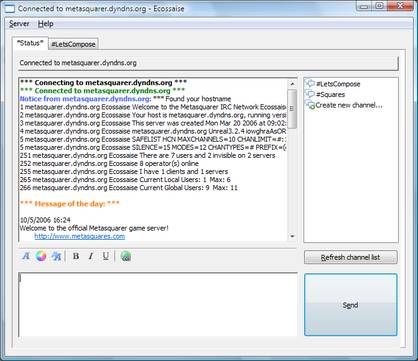 Thumbnails: 1 2 3 4 5
|
After completing the "Let's Compose! Collaborator" plugin, I decided to release the IRC client component of the plugin as a standalone application, which I termed "Ecossaise".
This client is extremely sophisticated, yet extremely lightweight (it takes up about 500kb on disk when statically linked to its dependencies and about 180kb when dynamically linked) because it is coded using C++ and the Win32 API, without bloated layers such as .NET or MFC on top of the application. It can plug into Finale, with more applications planned.
It is also itself extensible; that is, developers may write scripts and plugins for the IRC client itself.
It is something I am quite proud of, and I can care less whether anyone uses it. It is art, as much as any of the more overt works of art on this site are, and I need no other reason to justify its existence. Nevertheless, I may try marketing it later if I resume the "Let's Compose!" project.
This project, coupled with its collaborative functions, is around 15,000 lines of C++ code.
Date: July 25, 2006.
|
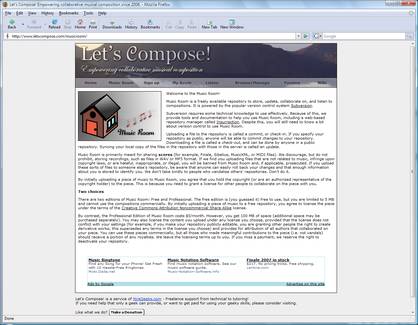
|
Let's Compose! was an initiative I began in the summer of 2006 to keep myself occupied following graduation and presentation of my number theory research.
The idea is simple yet unique: embed collaborative editing functionality into a mainstream music notation editor, such as Finale or Sibelius. Some peripheral ideas grew from this one as well: free subversion hosting for music, an "opensource music repository" of original sheet music, a browser plugin for viewing MusicXML files as sheet music, and even publishing and CD compilation of selected works from the site.
Unfortunately, the current state of the software made this extremely difficult: of all popular commercial music editors, only Finale had support for a sophisticated plugin such as the one I was writing (called Let's Compose! Collaborator), and I had to essentially trick Finale into thinking my plugin had terminated while it was still running in Finale's address space (by spawning a new thread). Moreover, the plugin development kit was out of date and documentation was sparse.
Despite these issues, I completed collaborator (and made good headway on the subversion repository, called "music room") in approximately two months. The first release encapsulates a very sophisticated IRC client, which I later split off into a standalone project called "Ecossaise".
However, unable to find sufficient support among composers to even beta test the application (collaboration in the arts is taboo, apparently, which is foolish considering how useful it is in the sciences), I was forced to accept that the field is not yet ready for such a tool.
One day, perhaps over the summer of 2007, I plan on marketing the product and publishing it commercially, since offering it for free did not work.
Date: June 1, 2006.
|
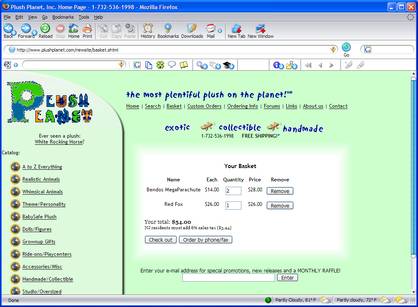 Thumbnails: 1 2
|
Plush Planet is a small business that specializes in plush renditions of many types of animals. This concept extends beyond Teddy bears; Plush Planet carries everything from alligators to wooly mammoths.
In March of 2005, I was asked to redesign the Plush Planet website and rewrite the very buggy and completely unmanageable backend code that the last web designers to work on the site had written. Though the former code was in PHP, I chose to rewrite the code in Perl, as there was high demand for advanced string parsing on the site. I also took the opportunity to add encryption to the site and SSL-enable the order page, as credit card numbers were previously being sent and stored in plaintext.
The thumbnails display the new design.
Date: March 7, 2005.
|
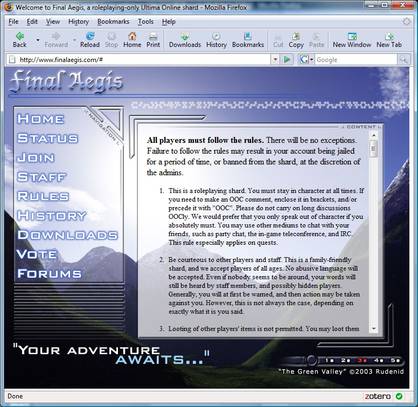 Thumbnails: 1 2 3 4
|
Final Aegis is an Ultima Online "freeshard" I've run (under the handle "Rudenid") since 2001 using the SphereServer emulator.
Though the action of running the shard itself is an interesting demonstration of early leadership ability, I list it here because it was also a demonstration of superior technical ability from an early age.
If you check the second thumbnail, you will notice something that looks somewhat like code. That is SphereScript, the script you are looking at is "NPC Quests v3.0", an automatic quest system, and I am (or was) known (again, under the handle Rudenid) as one of perhaps the two or three finest scripters in the world, probably because I routinely script very complex things (like the quest system, ferries, seasons, and a time magic system) that lie far beyond what most people think the language is capable of. I was certainly among the most prolific, writing over 100 scripts in a period of less than two years.
The scripting language itself is Turing complete within its own domain, but cannot write directly to memory or interface with the underlying filesystem or OS (in the version of Sphere I've used; it now can). It also tends to kill the server if more than 40 or so recursive calls are made.
In addition, it was an experiment in web design which is unfortunately looking somewhat dated right now because it is a fixed design from when 800x600 was the resolution to design for. Nevertheless, the underlying design is an example of an evolutionary period in my web design style.
Of course, the goal of all this isn't to make nifty things, but to provide the best experience to players. After some extended downtime between 2004 and 2007 (due to a lack of hosting), the shard has only a fraction of its former population, but every new introduction to the shard retains that goal, even while stretching the bounds of the possible.
I can provide samples of any number of my scripts on request. Their quality is not indicative of proficiency with any particular language, but is likely indicative of my general programming aptitude.
Date: June 1, 2001.
|
| |
During March 2008, I coded an entire backend system in Perl for the R.I.C.K. Foundation, a 501(c)(3) nonprofit dedicated to providing scholarships for inner city children. The system includes authenticated mechanisms for posting informational materials such as essays and videos as well as for leaving comments. Due to an ever-growing library of modules I have been building for such tasks, it occupies a mere 2,000 lines of Perl code (compare with the 15,000 lines that is HireGeeks).
Date: March 15, 2008.
|
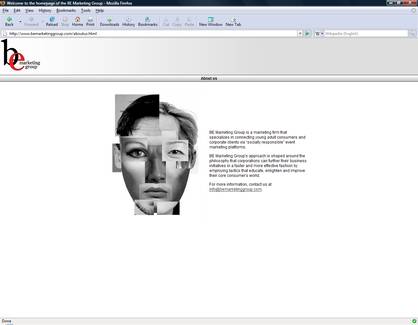
|
This was a short project that I completed for the BE Marketing Group. It features a single "About us" page and a flash introduction.
I have since been contacted for repeat work by BE.
Date: January 9, 2007.
|
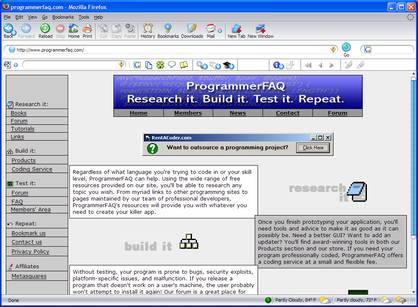
|
ProgrammerFAQ.com was the second website that I designed, but the first that I retain the record of. This website was designed to be a Q/A community for programmers, largely based upon my own perceived needs as a programmer at the time. Unfortunately, though an ambitious idea, the site failed to gain popularity and was eventually eclipsed by the wildly successful metasquares.com. I keep the site solely for email hosting purposes.
Date: November 20, 1998.
|
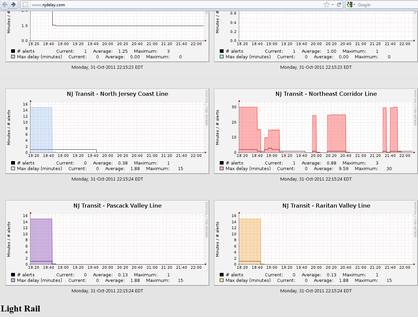
|
NJDelay is a historical delay and alert tracker for NJTransit buses, trains, and light rail lines. It is built using Cacti, Perl, and SSI coupled with mod_rewrite. Yes, I know Cacti. Yes, well enough to turn a system monitoring tool into something that can parse and plot train delays.
Date: October 29, 2011.
|
| |
Note: all past versions of my website draw from the same backend as the current one, and all remain functional with little maintenance. I obviously recommend you use the latest one for the best experience.
v3, "Final Frontier" (Jan 2014)
A fully responsive space-themed redesign of my personal portfolio, utilizing AngularJS and jQuery on top of HTML5 and CSS3. The hover menus are done in pure CSS. Go ahead, stretch that browser. Not only will portfolio items dynamically resize, but so will the text inside.
Third party components: AngularJS, jQuery, jQuery Cycle2, Shadowbox, HTML5Shiv, "Silk" icons (used in the music player), reCAPTCHA, and the iconic "Blue Marble" photo of Earth, taken by NASA and in the public domain.
All other content (c) 2014 Michael Barnathan.
Also of note: I completely redesigned my Flash audio player from v2 from the ground up to utilize HTML5. The music synthesizer still works as before, and much of the backend from v2 was reused.
v2, "Jung's Blackboard" (Jan 2006)
I decided in 2006 that my skill in web design had grown sufficiently since the first version of my portfolio that it was time for an update. This in particular was a good opportunity to demonstrate my newly-updated knowledge, particularly learning Flash.
We all know what happened to Flash, and its demise likewise motivated the third iteration of the website in early 2014.
Third party components: "Silk" icons (used in the music player), reCAPTCHA (used to protect the improv synthesis from spambots).
v1, "Thought Bubble" (2002)
The first version of the site. I'm not sure what possessed me to start it - I think I was looking for a historical record of everything I had worked on - but I know that I wanted to create a CMS in Perl (this was right before WordPress was released in 2003. Alas, I was academically-minded then, and didn't think to generalize and commercialize my system).
There's not much to say about the frontend of this site, as it was whatever HTML4 and XHTML 1 (still a new standard) that I had cobbled together at the time. The concept was to create an aleatoric, playful experience, where users were always greeted warmly, but in a slightly different way with each visit.
The Perl + MySQL backend was where this site shined, and it was so well-engineered that it's undergone few changes since the initial launch. All nontrivial functionality of the backend is split into Perl modules and decoupled with the rendering, though that rendering was still performed server-side until v3 (when I switched to outputting JSON and performing rendering on the client side using AngularJS).
Third party components: None, I was a cowboy at this age. Even the hosting was all built up from scratch on a self-managed Gentoo Linux dedicated server.
Date: January 28, 2014.
|
